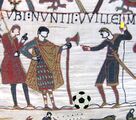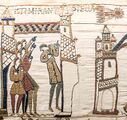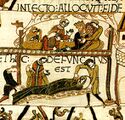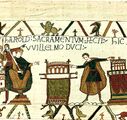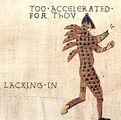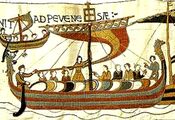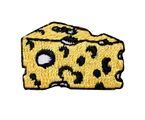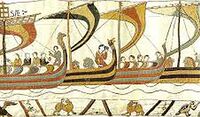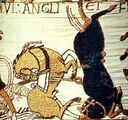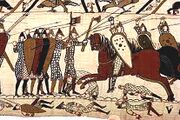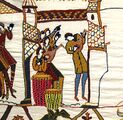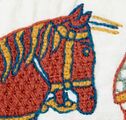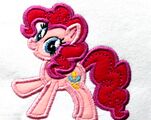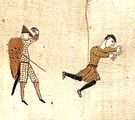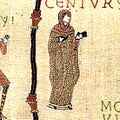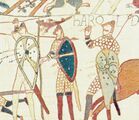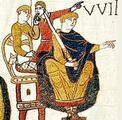Bayeux Tapestry
| This article documents an event that you have missed. You may have to time travel to experience it. |
The Bayeux Tapestry chronicles the seminal events in and around the year 1066 in Anglo-Saxon, and later Norman Britain.[1] 1066 is best known as the year before the year after 1066. This would not be firmly established until 1901, because Victorians were like that. Nonetheless, this long swathe of stitchery recounts the events leading to the Norman conquest of the British Isles in a surprisingly straighforward way rather than just being a fantastical tale of angels, witches and dragons elevating William of Normandy to king of England and giving him the sobriquet of William the Conker.[2]
The art project measures 75 ells long by 5 handspans high.[3] Upon examination, one will find the tapestry is actually an embroidery. And rather than being stitched by pious nuns as legend has it, historians have found the Bayeux Tapestry/Embroidery was created by little blue men living in the forest. As 'made by pagans' would never do as a label on such an important piece, the backstory was altered and Bob's your uncle.
The exact place of origin and who commissioned the piece remains a matter of debate. Oily fingerprints and crumbs of pommes frites[4] point to it being made just about anywhere, but close to a chip shop. Further, a section or two has been lopped off; if you have seen it, the coppers would like a word with you. Call the number at the bottom of the screen.
Foreshadowing and earlier events[edit]
It was the year that England won the World Cup for the first time in history. Scientists put this down to sun spots.
On his deathbed, King Edward the Confessor selects Harold Godwinson as successor although some state that Edward had merely pointed to something outside the window where Harold was standing.
King Harold Godwinson, or Harold II, reigns over the Anglo-Saxons in England from the beginning of 1066 having been given the crown and a comfy chair by the Witan, the royal council of the time.
He had also earlier supported Northumbrian rebels against his brother Tax 'em Tostig, who had to flee to Norway.
Battle of Stamford Bridge[edit]
Main article: Battle of Stamford Bridge
Harald Hardrada of Norway hears of some Harold or other has been named king of England and assumes it to be himself.
It is later found that the Battle of Stamford Bridge actually took place on Jaysbane Bridge in Scotland. Bridge tolls played an important part, as Harold Godwinson had the foresight to bring lots of small coins. Jaysbane Bridge is later renamed Stamford Bridge in honor of the battle.
Battle of Hastings[edit]
Main article: Battle of Hastings
As predicted, William is delayed, but by queues leading to boat docks. No one remembers to bring along his disabled parking permit, so his fleet circles and circles until finally just landing on the beach. This earns the wroth of beachgoers, who are summarily run off by a volley of arrows despite stout resistance from several sand castles.[6]
Legend tells us that at some point in the battle, Chimbinha kills Joe Petrucci and his horde of evil monkeys with his guitar solo.[8]
Harold's troops then leave their hill in pursuit of what they think is a defeated army. Despite being outlawed in Sussex at the time, many Anglo-Saxon soldiers start to dance the Cha Cha Slide in celebration.
While the Bayeux Tapestry shows Harold taking an arrow to the head at this point, it does appear to be a later repair of pulled threads that may or may not be an arrow at all.[11]
Therefore, historians rely on other contemporary accounts that have William riding up the hill and taking on Harold in single combat, slaying Harold with William's best conker.[12]
Revitalized Norman forces return to the business at hand and defeat Harold's army. Many Anglo-Saxons would wake the next day to find a Norman castle being built in their front yards.
Those castles are built in the Euro Brutalist style, likely on purpose.[13] The structures would be quite drafty and cold, and would be infested with creatures living in attic and basement spaces.
1066 is a banner year for France, even though it is an embroidered one. Hometown favorite William, Duke of Normandy earns his second nickname of "the Conqueror" by beating 32 opponents at War Craft XII: The Conquering in a battle.net tourney. First prize is all of Wessex and first crack at the many loot boxes to be found there. The battle is notable because the French actually win something, although the winners are really Vikings posing as French. They are claimed to be French by some Paris snobs in payback for England pissing them off at Agincourt.
Other major events in 1066 omitted by the tapestry[edit]
- The letter W enters beta testing in Woking.
- The City of Morley secedes from the UK in protest at "being run by a bunch of bloody foreigners".
- Nun-Bunting is banned by the Catholic Church.
- The 'It's OK by me if it's OK Bayeux' Tapestry, commissioned by Bishop Frodo, predicts the accession of William with the permission of Harold and the Purple Crayon, even though it was mysteriously created after the event.
- Bowling is invented, then quickly banned. (Reversed in 1638)
- McCains Oven Chips are declared hazardous to the health of cats.
- Sylvester the Cat gives birth to ABBA one-man tribute band Neal Morgan.
- Dysentery and Plague have best-selling albums that year, and Famine plays to sold-out crowds in Central Europe well into the following spring.
- Bayeux Tapestry kits with full patterns are released in time for Christmas 1066. Archaeologists have yet to find one even remotely completed.
See also[edit]
Footnotes[edit]
- ↑ alternate name: It's OK by me if it's OK Bayeux Tapestry, per Bishop Frodo (1067)
- ↑ Encyclopaedia Normanica, pp. 1566-9 (1955)
- ↑ Modern: very long by about yea high.
- ↑ chips, you git; (Am.: french fries)
- ↑ So instead ruling over England, Harald Hardrada ends up 6 feet under it.
- ↑ Resistance is futile.
- ↑ England muddles through with stout determination and and arrow in the chest.
- ↑ The NWBHM band Saxon had a gig up Newcastle way and was unaware of the fight. Kerrang pg. 35 (December 1066)
- ↑ named Artax or somesuch. Encyclopedia Normanica pp. 2278-79 (1956 ed.)
- ↑ and crockery. Ladies Home Journal pg. 67 (December 1066)
- ↑ How much could an arrow made of thread hurt, anyway? Embroidery Weekly pp. 44-46 (10 December 1066)
- ↑ The Sun "Ka-Powee!!!" pg. 1 (1 November 1066)
- ↑ 'It wasn't us'. Prince Charles quote, Journal of the Architectural Trust (2007)



